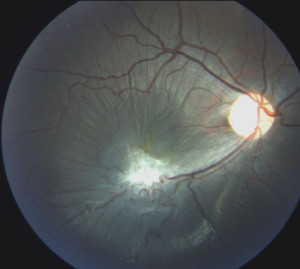This condition has a variety of names, all of which relate to the same findings. These include macular pucker, cellophane maculopathy, and premacular gliosis. All these terms describe the presence of a scar tissue which grows over the surface of the macular, the central region of the retina, it is responsible for providing fine vision can develop spontaneously or they can develop secondary to other ocular conditions.
Many patients with an ERM may be asymptomatic or may have normal vision. However, as the scar tissue grows and contracts, it can cause the retina to become more wrinkled. As the retina becomes more distorted, the patient may experience when mild distortion to blurred vision. The onset is slow but visual symptoms can sometimes become progressive.
Once patients develop symptoms, your eye doctor will make the diagnosis of an epiretinal membrane after a dilated retinal examination. A fluorescein angiogram and/or OCT may be recommended to help evaluate whether there is leakage in the retina associated with the scar tissue. Treatment is not indicated unless the patient is bothered by one’s symptoms. The only definitive treatment to remove the scar tissue is with a surgery called vitrectomy. Surgery can be considered if the patient’s visual complaints are disturbing and create difficulty for them to function. It also considered if there is significant leakage noted on fluorescein angiography which would cause a risk to the patient’s vision over time. Specialized instruments are used to peel the scar tissue from the retinal surface. It may take up to 2 – 3 months to gain back the majority of vision after the surgery. However, patients who have had epiretinal membrane present for extended periods of time or have significant leakage may take longer for recovery. This depends on many different issues including how long the pucker has been present, whether there is associated retinal vascular leakage, or if there is a significant cataract. Statistics show that the majority of patient’s visual improvement is at least 3 lines achieved, but again this depends on the preexisting findings. Some patients may achieve 20/20 vision, although this is less likely. Typical symptoms such as distortion and blurriness are alleviated with successful surgery.
Macular Pucker / ERM

